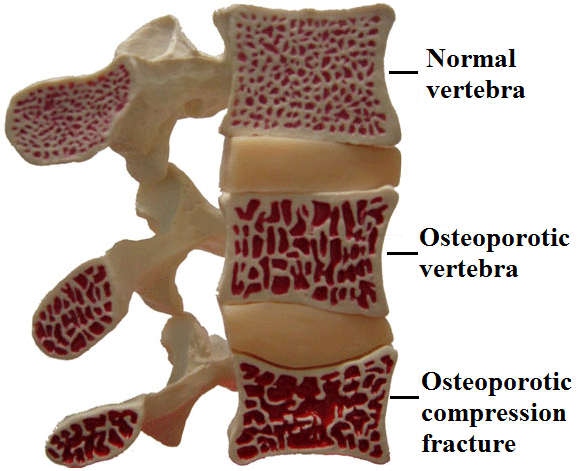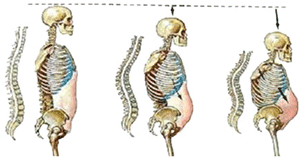OSTEOPOROTIC FRACTURES
 |
The spinal column is made up of bones named vertebrae, one on top of the other, that protect the spinal cord. As with any bone, the vertebrae have an outer shell, the cortical bone, which is hard and strong. The inside of the vertebrae, however, has cancellous bone, which is soft and spongy. Osteoporosis is the disease that causes this cancellous bone to become weaker and weaker. Osteoporosis is characterised by a reduction in bone density, leaving the bones fragile and susceptible to fracture spontaneously or after a minor accident, and since it is a “silent disease”, many patients are not diagnosed until one of their bones breaks. These fractures are called osteoporotic fractures and are especially common in the hips and vertebrae. Osteoporosis can, however, be prevented with a healthy lifestyle, including a calcium rich diet, no smoking, moderate alcohol consumption and avoiding some types of medication. |
|
Stages of vertebral osteoporosis
|
It should be remembered that:
- 1 in every 2 women and 1 in every 4 men over age 50 will have an osteoporosis-related fracture at some point in their remaining lifetime.
- Osteoporosis is responsible for more than 1.5 million fractures annually, 700 000 of which are vertebral compression fractures.
- 80% of those affected by osteoporosis are women.
Osteoporosis prevention and treatment is vital to reduce the risk of new fractures. To prevent and treat osteoporosis, medication, diet supplements and lifestyle changes may be needed.
 |
A vertebral compression fracture occurs when a vertebra collapses onto itself due to the weakening and thinning of the spine’s bones. These fractures often cause pain, disability, loss of height and decreased mobility. It can also lead to digestive, pulmonary and even sleep disorder.
|
|
Height loss due to osteoporosis
|
A fracture affecting several vertebrae can result in a kyphosis (hump-like curving of the spine). The abnormal pressure and alignment of the spine can result in pain, numbness, tingling or weakness. It may be difficult to walk or to undertake normal daily activities. In extreme cases, the fracture can lead to breathing problems due to the reduction in lung capacity.
CAUSES OF VERTEBRAL COMPRESSION FRACTURES
Vertebral compression fractures are caused by trauma, osteoporosis and tumours, mostly metastatic. Osteoporosis, the most common cause, reduces bone density, so vertebral compression fractures can happen with minor trauma or no trauma at all. These fractures most commonly occur in women who have gone through menopause, but they can also occur in elderly men and in people that have taken corticosteroids for a long time.
VERTEBRAL COMPRESSION FRACTURE SYMPTOMS
Vertebral compression fracture symptoms can include one or more of the following: sudden pain with a belt distribution, limited spinal column mobility, height loss and increased pain while standing and/or walking. In any case, some radiological studies will be needed to confirm the clinical diagnosis.
HOW ARE VERTEBRAL COMPRESSION FRACTURES TREATED?
 |
Some fractures are clinically unstable, involving pressure on the spinal cord or spinal nerves. In these cases, which are quite rare, surgery may be necessary. The majority of fractures, however, are stable and will be treated with conservative methods, such as analgesics, orthesis (external bracing, corset), or prolonged bed rest. However, these methods do not necessarily relieve the pain nor solve the problems derived from the medication and inactivity.
|
|
Intra-operative picture while performing a vertebroplasty
|
Open surgery is a highly invasive and difficult procedure when treating osteoporotic bone. It requires a long hospital stay and post-operative rehabilitation, so a minimally invasive procedure, called a vertebroplasty, is usually carried out. It is performed in a radiology suite or in a surgical theatre, local anaesthesia is used to numb the area and prevent pain, and a light sedative is administered to increase patient comfort during the procedure. Occasionally, some patients will require general anaesthesia.
Through a puncture and guided by X-rays, a narrow needle is passed through the spinal muscles, until its tip is reaches the inside of the collapsed vertebral body. Acrylic bone cement is then injected through the needle into the vertebral body, filling the existing spaces in the damaged bone. As the cement hardens, it stabilises the fractured vertebra, relieving the pain.
WHAT ARE THE BENEFITS OF A VETEBROPLASTY?
Pain relief is usually immediate and most patients display a considerable level of pain relief within 24 hours following the procedure. After a few days, many patients are able to significantly reduce their doses of pain medication and may even become symptom-free. In addition, 75% of patients regain lost mobility and become more active, which helps fight osteoporosis.
WHAT ARE THE POSSIBLE COMPLICATIONS?
Even with a minimally invasive procedure there are potential risks and complications which should be taken into account. Complications are rare, but they may happen.